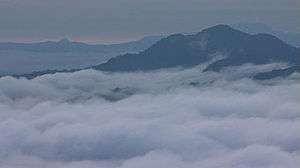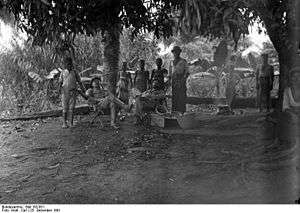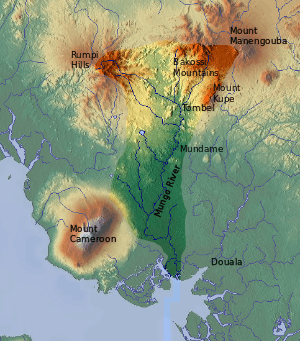Bakossi people
The Bakossi people live on the western and eastern slopes of Mount Mwanenguba and Mount Kupe in the Bakossi Mountains of Cameroon. They number about 200,000, mostly engaged in subsistence farming but also producing some coffee and cocoa.[1]
 Bakossi house in 1920 | |
| Total population | |
|---|---|
| 200,000[1] | |
| Regions with significant populations | |
| Bakossi Mountains (Cameroon) | |
| Languages | |
| Akoose | |
| Religion | |
| Christianity | |
| Related ethnic groups | |
| Mbo |
Origins
According to their tradition, the Bakossi are descended from the great hunter Ngoe (or Ngweh) and his beautiful wife Sumediang. They had twelve children. At one time, a supernatural being warned the couple that a flood was coming and told them to make a box in which to escape. They built an ark, taking in their family and all kinds of animals, and survived the flood. The ark came to rest between the twin lakes of Mwanenguba, one of which is said to have a female character and the other male.[2] The different clans claim descent from different children and grandchildren of this couple.[3]
The Bakossi are related to other people of the region including the Bafaw, Bakundu, Balong, Bassossi, Mbo, Abo, Miamilo, Baneka, Muaneman, Muange, Bareko, Bakaka, Babong, Balondo, Manehas, Bongkeng, and Bakem.[3] The Bakossi people speak a Bantu language called Akose. Today, this language includes many loan words from English, French and word that are also found or related to words in Douala.[4] Ethnologue classifies the language in the Ngoe group of the Lundu-Balong family.[5]
Environment

The land occupied by the Bakossi people includes both highlands and lowlands. It has fertile soils, watered by streams that rise in the mountains, and is covered by dense forest which contain a wide variety of trees, birds and animals.[1] Many of the Bakossi grow coco yam, cassava and some corn for food. For cash they cultivate coffee in the higher parts and cocoa lower down.[6] More exotic foods include tadpoles and males of the Hairy Frog, which are thought to fall from the sky and, when eaten, to help childless human couples become fertile.[7] Among the Bakossi, a hunter is respected for his skills and achievements as much as for the economic value of the animals he has managed to kill.[8]
The Bakossi Forest Reserve of 5,517 square kilometres (2,130 sq mi) was created in 1956. In 2000, the main section of Bakossi was designated a protected forest. All logging was banned and Kupe became a "strict nature reserve". The local Bakossi people participated in delineating the boundaries.[9] There were large gains in management effectiveness of the forest between 2003 and 2007 although the local people are still not well integrated into management of the area and there are weaknesses in education on environmental subjects.[10]
Traditional beliefs
The Bakossi beliefs and customs included belief and participation in jujus, a rather vague concept where the name of a juju might apply to a secret society, objects such as masks associated with the society, and certain magical powers. Mwakum was the most powerful of all the jujus, invisible, mysterious and full of magic. Some jujus were restricted to men of a certain age and demanded an initiation fee. Jujus and their ceremonies kept peace in the villages, warded off evils and detected the presence of witches.[11]
The Bakossi people attached sinister magical properties to Mount Kupe. They believed that Nyongo, or members of the ekom association of witches, could put people to work on invisible plantations on the mountain. While still living, the future slaves would be given to a witch by a greedy relative in return for joining the association and gaining a plantation. After they appeared to die, but in fact became ekongi, the relatives were stolen from their graves by the witches and sold to a plantation owner.[12] The practice of visiting a trader in ekongi is reported from 1962 in Douala, the commercial capital of Cameroon. The "ekongeur" would throw his visitor into a deep sleep through hypnosis. He would see the plantations with the ekongi working, and would be offered a plantation in return for someone such as his mother. On waking up, the ekongeur would explain that he now should take his time to decide what he would do...[13] There may be an echo in this belief of early experiences with the slave trade.[12]
The Nyongo could also find closed bundles on the mountain which might contain either riches or misfortunes, including illness and death. The bundle had to be brought back unopened and immediately thrown in the river if it was found to contain bad luck.[12] By the 1950s a belief had risen that anyone who could afford a modern house with a tin roof must be a Nyongo, earning his wealth from the labors of his dead relatives. There was a reluctance to build such a house, even if the owner visibly did the work with his own hands and none of his relatives died. When a witch died, he could also become an ekongi. To prevent this, he might be buried face down so he could not rise, perhaps with his head severed from his body.[14] These beliefs are now discredited. Heinrich Balz, in his 1984 study of the Bakossi, Where the Faith Has to Live, reported that before dying the last Ekom men left a message that there was no longer anything good to be found on Koupe. To get wealthy the people should take their cutlasses and open farms in the bush.[15]
The Bakossi observed a ten-day cycle rather than the seven-day week common elsewhere. As elsewhere, they did not align their weeks with months.[16]
Pre-independence history

The different Bakossi tribes originally each occupied independent territories, living as hunter-gatherers.[3] As the Atlantic slave trade developed, the coastal town of Douala became an important trading center, reaching into the interior Bakossi Mountains along the Mungo valley. However, by the 1840s the slave trade had been replaced by the palm oil trade. Little is known about the effect on the Bakossi of either trade, but they were certainly involved in both. In nearby regions, slaves were still used domestically on palm oil plantations as gatherers, processors and carriers long after the export of slaves to the USA, Caribbean and Brazil had ceased.[17]
During the European colonial era, the Bakossi came under German rule in the 1880s, and then, after World War I, their land was split between British and French colonies.[3] The Mungo River, which flows through Bakossi territory, was taken as the southern boundary between the two colonies. Starting in the first half of the 20th century, Bamileke people began to migrate into Bakossi territory, particularly to the Tombel area, where they found work on the plantations and escaped the harsh forced-labor conditions on the French side of the border. They were welcomed by the Bakossi, who gave them land in return for free labor.[18] The use of laborers in this way was consistent with the Bakossi's memories of employing slave labor and their belief in the invisible slave plantations on Mount Kupe.[19]
In 1953, the Kumba Eastern Area Federation was established as an indigenous authority covering all the Bakossi.[3] In the period immediately following World War II, the Bakossi people enjoyed a period of prosperity. Cocoa prices were high, and the farmers did not have to work since they could employ a sharecropper to tend the crop in return for one-third of the earnings. With nothing else to spend their money on, the men would buy cases of Spanish gin and brandy, consuming the booze in long drinking bouts that lasted all night. By the 1960s, the hangover set in as the people started to realize the need to invest in more important things, particularly education and became aware that they may have lost control of their land.[19]
Post-independence troubles

The modern independent state of Cameroon was formed in 1961 when the southern part of the British Cameroons united with the Republic of Cameroon, which had succeeded the French colony of Cameroun in 1960.[20] The Bakossi were opposed to the union, and the Mwane-Ngoe Union of the Bakossi asked the United Nations to respect their wish to avoid the conflict in Cameroun and instead let them join Nigeria.[21] At first the Southern Cameroons retained a degree of independence in a federation between two states.[22] Full unification was resisted by the people of Southern Cameroons since they had a more democratic society than prevailed in the rest of the country under the oppressive regime of Ahmadou Ahidjo.[20] In 1963, the Bangem District was created covering the land occupied by the Bakossi.[3]
In the late 1950s and early 1960s, tensions began to rise between the Bakossi and the Bamileke people, who were becoming increasingly successful as farmers. The UPC rebellion broke out in the French territory in 1955, with Bamilekes prominent among the rebels. A growing number of Bamileke fled from persecution in the east and settled with their kin in Bakossi country. After unification in 1961 the UPC rebels came under increasing pressure and their numbers shrank. The remainder turned to living off the land, demanding supplies from the villages and capturing youths whom they inducted into their forces.[18]
By late 1966, medicine men were active in distributing secret medicines which would give the Bakossi men courage and make them immune to bullets or machete strokes. After three Bakossi were killed by unknown assailants on 31 December 1966, the Bakossi went on a rampage, killing 236 Bamileke settlers, looting and burning their houses. In response the army moved in, rounded up all able-bodied Bakossi men in the Tombel area, and placed them in detention camps. Many were severely tortured to obtain confessions. Eventually 143 Bakossi men were put on trial and 17 sentenced to death. 75 received life sentences of life imprisonment.[18] Bangem District was split into Northern and Southern districts in 1968, and, in 1977, the Bakossi Council was also split into Northern and Southern councils.[3]
Economic difficulties
Cameroon is a poor country, with a 2010 GPD per capita of US$2,300, placing it 183 among countries by wealth. Most of the people are engaged in agriculture.[23] After independence the government faced growing demand for rural water supply. The government required that local communities provide labor to build the water facilities between 1964 and 1988, providing water through public taps. However, local councils found that the cost of supplying water to these taps was eating up a large part of their budget. When they failed to pay their bills the National Water Supply Company of Cameroun (SNEC) simply disconnected the supply. Starting in 1993 the SNEC tried privatizing the taps to reduce waste and recover costs, with an individual running the tap and selling the water. The Bakossi women of Tombel made a dramatic protest against these changes. In April 1994, 4,000 women marched on the SNEC offices, led by some old women who marched naked - their final weapon before death - and urinated on the steps. Herbs were thrown on the steps, which were said to be able to turn into poisonous snakes if anyone crossed the threshold. The SNEC employees had fled and refused to return from fear of the people and of the juju the women had placed. The outcome was partial success. Control of the water supply was given to a committee headed by the woman who had organized the protest. But the supply remained uncertain.[24]

As of 2008, young Bakossi farmers faced the difficult choice of trying to make their way in the city or taking their chances in rural development. Some had started growing oil palms in Mbulle but lacked a processing machine, fertilizers and chemicals. Most important they lacked roads and transport to get their crops to market. Earlier cooperatives that gave some collective bargaining power had been disbanded leaving cash crop farmers at the mercy of private buyers.[25]
Prominent people
Albert Ngome Kome was a leading political figure of the Bakossi people.[26] He was Minister of Transport from 8 November 1979 to 17 July 1984 under the governments of Ahmadou Ahidjo and his successor Paul Biya.[27] A 2006 article described Kome as a member of the Kupe Muanenguba elite, which also included Mr Ekinde Sone Bernard Ivo, an educationist and politician; Professor Elvis Ngolle Ngolle, appointed Minister of Forests and Wildlife on 22 September 2006; Chief Justice Epuli Aloh Mathias;[28] Professor Charles Epie Alobwede; Professor Paul Ndue; Thomas Kolle Ekaney; Late Chief Lucas Nzuonkwelle; Ambassador Nkwelle Ekaney; Mr. Ngole Philip Ngwese; Makoge Ivo Charles; Nhon Mesue Stephen Nzuonkwelle; Nhon Nzuonkwelle Emmanuel Nkwelle; Ajuoh Emmanuel Ekwe; Ekinde Eugene Epie; Mesue Gilbert Ekane; Ngwesse Dominic Alekeh; Kange Solomon Ekane; CD Ewu Ngeme David; Chief Ewange Elias of Babubock; Mme Ngumbah née Mesue Juliana Mbende; Nicolas Nkwelle Metuge; Nhon Nkwelle Jude Nzuonkwelle; General Ekongwese Divine Nnoko, appointed Military General on a presidential decree of 29 June 2017; Paul Elung; chief Alex Ngome Ntoko; Chief Nhon Nzoh Ngandembou; Hon. John Ebong Ngole; Dr. Nkwelle Akede Aaron, a pediatrician; Manasseh Bobga, late Ebong Ngalamel and Late Justice Ngalame Kome, Supreme Court Justice and former Secretary of State.[29]
References
- S. N. Ejedepang-Koge. "BAKOSSI: INFORMATION NOTE". THE ALL BAKOSSI CONFERENCE. Retrieved 2011-02-11.
- Beatrice Fri Bime (2009). Mystique: a collection of lake myths. African Books Collective. p. 43. ISBN 978-9956-558-21-6.
- "History of the Bakossi". Bakossi Cultural & Development Association. Archived from the original on 2011-03-24. Retrieved 2011-02-11.
- "The Bakossi Language". Bakossi Cultural & Development Association. Archived from the original on 2011-03-24. Retrieved 2011-02-11.
- "Akoose, A language of Cameroon". Ethnologue. Retrieved 2011-02-11.
- Margaret Minzner. "Bakossi, Akoose of Cameroon". Joshua Project. Retrieved 2011-02-11.
- Legrand N. Gonwouo & Mark-Oliver Rödel (20 February 2008). "The importance of frogs to the livelihood of the Bakossi people around Mount Manengouba, Cameroon, with special consideration of the Hairy Frog, Trichobatrachus robustus". Salamandra. 44 1: 23–34. ISSN 0036-3375.
- Guy Cowlishaw; Robin Ian MacDonald Dunbar (2000). Primate conservation biology. University of Chicago Press. p. 401. ISBN 0-226-11636-0.
- Cornelius Mbifung Lambi; Emmanuel Ndenecho Neba (2009). Ecology and Natural Resource Development in the Western Highlands of Cameroon: Issues in Natural Resource Management. African Books Collective. p. 87. ISBN 978-9956-615-48-3.
- Giuseppe Topa; World Bank; Carole Megevand; Alain Karsenty (2009). The rainforests of Cameroon: experience and evidence from a decade of reform. World Bank Publications. p. 80. ISBN 978-0-8213-7878-6.
- Peter Valentin, ed. (1980). Jujus in the Forest Area of West Cameroon. Basel: Basler Afrika Bibliographien. p. 7ff.
- Paul Clough; Jon P. Mitchell (2001). "The Temptations of Mt. Kupe: The Witchcraft of Wealth and Its Variations". Powers of good and evil: moralities, commodities, and popular belief. Berghahn Books. p. 56ff. ISBN 1-57181-992-4.
- Roy Richard Grinker; Christopher Burghard Steiner (1997). Perspectives on Africa: a reader in culture, history, and representation. Wiley-Blackwell. p. 355. ISBN 1-55786-686-4.
- Mary Douglas (2004). Witchcraft Confessions and Accusations. Routledge. p. 147ff. ISBN 0-415-33070-X.
- Elizabeth Isichei (2004). Voices of the poor in Africa. University Rochester Press. p. 103. ISBN 1-58046-179-4.
- Willi Schaub (1985). Babungo. Taylor & Francis. p. 251. ISBN 0-7099-3352-5.
- Z.A. Konczacki; J.M. Konczacki, eds. (1977). The pre-colonial period: Volume 1 of An economic history of tropical Africa. Routledge. p. 150. ISBN 0-7146-2919-7.
- Piet Konings (2009). "Factors underlying the 1966 Bakossi-Bamileke confrontation". Neoliberal Bandwagonism: Civil Society and the Politics of Belonging in Anglophone Cameroon. African Books Collective. p. 39ff. ISBN 978-9956-558-23-0.
- Peter Geschiere; Janet Roitman (1997). The modernity of witchcraft: politics and the occult in postcolonial Africa. University of Virginia Press. p. 265. ISBN 0-8139-1703-4.
- Carlson Anyangwe (2008). Imperialistic politics in Cameroun: resistance & the inception of the restoration of the statehood of southern Cameroons. African Books Collective. p. 64. ISBN 978-9956-558-50-6.
- Bongfen Chem-Langhëë (2004). The paradoxes of self-determination in the Cameroons under United Kingdom administration: the search for identity, well-being, and continuity. University Press of America. p. 179. ISBN 0-7618-2504-5.
- John Percival; Lalage Neal (2008). The 1961 Cameroon plebiscite: choice or betrayal. African Books Collective. p. 4. ISBN 978-9956-558-49-0.
- "Africa::Cameroon". CIA. Retrieved 2011-02-10.
- Anne Coles; Tina Wallace (2005). Gender, water and development. Berg Publishers. p. 68. ISBN 1-84520-125-6.
- Jürgen Thiesbonenkamp; Andreas-Martin Selignow (Hg.) (2009). Interdisziplinare Afrikaforschung und neuer Afropessimismus. Symposion zum 70. Geburtstag von Heinrich Balz. Andreas-Martin Selignow. p. 149. ISBN 3-933889-13-8.
- James Stuart Olson (1996). "Bakossi". The peoples of Africa: an ethnohistorical dictionary. Greenwood Publishing Group. p. 59. ISBN 0-313-27918-7.
- "Cameroon National Shippers' Council" (PDF). Cameroon National Shippers' Council. Archived from the original (PDF) on 2011-07-25. Retrieved 2011-02-11.
- "Epuli Mathias Aloh: Retour à la maison".
- Joe Dinga Pefok (28 September 2006). "Kupe Muanenguba Exhorted To Support Ngolle Ngolle". Up Station Mountain Club. Retrieved 2011-02-11.